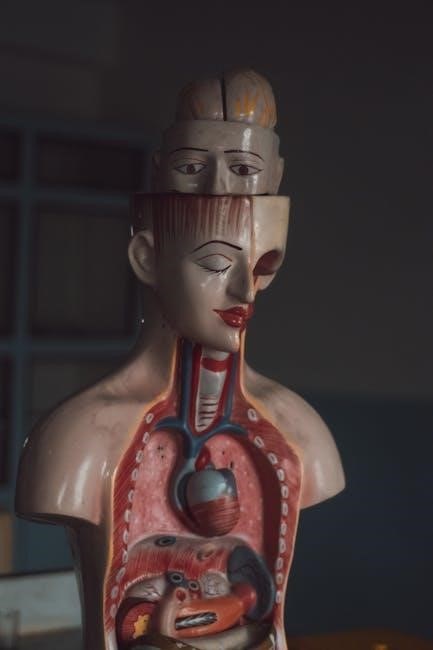
The human body is composed of 11 interconnected organ systems‚ each performing unique functions essential for maintaining homeostasis and overall health․ These systems work collaboratively to sustain life․
Integumentary System
The integumentary system‚ the body’s largest organ‚ protects deeper tissues‚ regulates temperature‚ and excretes wastes․ It includes skin and accessory organs like hair‚ nails‚ and glands․
1․1 Overview of the Integumentary System
The integumentary system is the body’s outer layer‚ primarily consisting of skin and its appendages․ It acts as a protective barrier against external factors like pathogens‚ UV radiation‚ and physical damage․ Additionally‚ it plays a crucial role in regulating body temperature through sweating and insulating mechanisms․ This system also aids in the excretion of waste products‚ such as water and salts‚ through sweating․ Furthermore‚ it contributes to the synthesis of vitamin D‚ essential for bone health․ Overall‚ the integumentary system is vital for maintaining homeostasis and protecting internal tissues from environmental stressors‚ making it indispensable for overall health and survival․
1․2 Major Organs of the Integumentary System
The integumentary system consists of several key organs and structures‚ with the skin being the largest and most prominent․ The skin serves as the body’s primary protective barrier and is divided into layers: the epidermis‚ dermis‚ and hypodermis․ Accessory organs include hair‚ nails‚ sweat glands‚ and sebaceous glands․ Hair provides insulation and protection‚ while nails safeguard the tips of fingers and toes․ Sweat glands regulate body temperature through perspiration‚ and sebaceous glands produce oils to moisturize and protect the skin․ These components work together to maintain the integrity and functionality of the integumentary system‚ ensuring protection‚ temperature regulation‚ and overall bodily defense․
Skeletal System
The skeletal system provides structural support and protection for the body‚ composed of bones‚ ligaments‚ and cartilage․ It works with the muscular system to enable movement․
2․1 Overview of the Skeletal System
The skeletal system is a framework of bones‚ cartilage‚ and ligaments that provides structural support‚ protection‚ and facilitates movement․ It consists of 206 bones in adults‚ varying in shape and size to perform specific functions․ The skeletal system works in conjunction with the muscular system to enable movement through leverage and muscle attachment․ Additionally‚ it protects vital organs‚ such as the brain‚ heart‚ and lungs‚ by encasing them in bony structures like the skull and ribcage․ The skeletal system also produces blood cells in the bone marrow and stores minerals like calcium and phosphorus‚ which are essential for bone health and overall bodily functions․ This system is dynamic‚ with bones constantly being remodeled throughout life to maintain strength and adapt to stress․ Its functions are crucial for mobility‚ protection‚ and metabolic processes․
2․2 Major Organs of the Skeletal System
The skeletal system comprises 206 bones‚ cartilage‚ and ligaments․ Major bones include the skull‚ vertebral column‚ ribcage‚ sternum‚ upper limb bones (humerus‚ radius‚ ulna‚ carpals‚ metacarpals‚ phalanges)‚ and lower limb bones (femur‚ patella‚ tibia‚ fibula‚ tarsals‚ metatarsals‚ phalanges)․ The axial skeleton includes the skull‚ vertebral column‚ and ribcage‚ while the appendicular skeleton consists of upper and lower limb bones․ Cartilage provides cushioning and smooth movement at joints‚ and ligaments connect bones‚ stabilizing joints․ These components work together to provide structural support‚ protect internal organs‚ and facilitate movement․

Muscular System
The muscular system consists of over 600 muscles‚ enabling movement‚ maintaining posture‚ and regulating body temperature․ It includes skeletal‚ smooth‚ and cardiac muscles‚ working together for bodily functions․
3․1 Overview of the Muscular System
The muscular system is a complex network of over 600 muscles‚ enabling movement‚ maintaining posture‚ and regulating body temperature․ It comprises three types: skeletal‚ smooth‚ and cardiac muscles․ Skeletal muscles‚ attached to bones‚ facilitate voluntary movements‚ while smooth muscles perform involuntary functions like digestion․ Cardiac muscle powers the heart’s contractions․ This system works in tandem with the nervous system to control muscle activity․ Muscles also produce heat‚ with about 85% of body heat generated through muscle contractions․ The muscular system is vital for locomotion‚ stability‚ and internal bodily functions‚ ensuring the body operates efficiently and maintains homeostasis․
3․2 Major Organs of the Muscular System
The muscular system is primarily composed of three types of muscles: skeletal‚ smooth‚ and cardiac․ Skeletal muscles‚ attached to bones‚ enable voluntary movements such as walking and lifting․ Smooth muscles‚ found in internal organs like the digestive tract‚ perform involuntary functions‚ such as peristalsis․ Cardiac muscle‚ exclusive to the heart‚ powers its rhythmic contractions․ Together‚ these muscles facilitate movement‚ maintain posture‚ and regulate internal processes․ They also generate heat‚ contributing to body temperature regulation․ The coordination of these muscles is essential for overall bodily functions‚ ensuring efficient movement and stability while supporting other systems like the circulatory and nervous systems․
Nervous System
The nervous system is a complex network controlling body functions‚ enabling thought‚ memory‚ and communication․ It comprises the brain‚ spinal cord‚ and nerves‚ regulating responses to stimuli․
4․1 Overview of the Nervous System
The nervous system is a intricate communication network that regulates various bodily functions․ It primarily consists of the central nervous system (CNS) and the peripheral nervous system (PNS)․ The CNS includes the brain and spinal cord‚ serving as the control center for decision-making‚ memory‚ and emotions․ The PNS connects the CNS to other body parts‚ facilitating sensory input and motor responses․ This system enables the body to react to external stimuli‚ maintain homeostasis‚ and coordinate voluntary and involuntary actions․ Its functions are crucial for survival‚ encompassing processes like nerve signaling‚ reflexes‚ and the transmission of information throughout the body․ The nervous system’s efficiency ensures seamless communication and control over bodily operations․
4․2 Major Organs of the Nervous System
The nervous system comprises several key organs that facilitate its functions․ The brain serves as the control center‚ managing decision-making‚ memory‚ and emotions․ The spinal cord acts as a messenger‚ relaying signals between the brain and the rest of the body․ Nerves are specialized tissues that transmit electrical and chemical signals‚ enabling communication throughout the system․ Sense organs‚ such as those in the eyes‚ ears‚ and skin‚ detect external stimuli‚ providing essential sensory input․ Together‚ these organs work harmoniously to regulate voluntary and involuntary actions‚ ensuring the body’s response to internal and external environments․ Their coordinated efforts are vital for maintaining overall physiological balance and enabling complex functions like thought‚ movement‚ and sensation․

Circulatory System
The circulatory system‚ comprising the heart‚ blood vessels‚ and blood‚ transports oxygen‚ nutrients‚ hormones‚ and waste products‚ maintaining homeostasis and regulating body temperature․
5․1 Overview of the Circulatory System
The circulatory system‚ also known as the cardiovascular system‚ is a vital network responsible for transporting oxygen‚ nutrients‚ hormones‚ and waste products throughout the body․ It consists of the heart‚ blood vessels (arteries‚ veins‚ and capillaries)‚ and blood․ The heart acts as the central pump‚ propelling blood through a closed-loop system․ Arteries carry oxygen-rich blood away from the heart to tissues‚ while veins return oxygen-depleted blood to the heart․ Capillaries facilitate the exchange of substances between blood and cells․ This system plays a crucial role in maintaining homeostasis‚ regulating body temperature‚ and supporting immune function by transporting white blood cells․ It also interacts closely with the respiratory and digestive systems to ensure efficient delivery of oxygen and nutrients․
5․2 Major Organs of the Circulatory System
The circulatory system comprises several key organs and structures essential for its function․ The heart‚ a muscular organ‚ pumps blood throughout the body․ Arteries‚ veins‚ and capillaries form an extensive network of blood vessels‚ with arteries carrying oxygen-rich blood away from the heart and veins returning oxygen-depleted blood․ Capillaries‚ the smallest vessels‚ facilitate the exchange of oxygen‚ nutrients‚ and waste products with tissues․ Blood itself is a vital component‚ consisting of plasma‚ red blood cells (which carry oxygen)‚ white blood cells (involved in immunity)‚ and platelets (essential for clotting)․ Together‚ these organs and components work seamlessly to ensure the delivery of oxygen and nutrients to cells and the removal of waste‚ maintaining the body’s overall health and function․
Lymphatic System
The lymphatic system supports immune function‚ filters lymph‚ aids digestion‚ and maintains fluid balance‚ ensuring proper bodily functions and overall health․
6․1 Overview of the Lymphatic System
The lymphatic system is a vital component of the human body‚ functioning as part of the circulatory system․ It plays a crucial role in immune defense‚ fluid balance‚ and detoxification․ The system consists of lymph nodes‚ lymph vessels‚ and the spleen‚ working together to filter lymph fluid and remove pathogens․ It transports lymph‚ rich in nutrients and waste‚ back to the bloodstream․ This system also aids in the absorption of fats from the digestive tract․ By maintaining fluid equilibrium and protecting against infections‚ the lymphatic system ensures overall bodily health and proper immune function․ Its interconnected network supports the body’s ability to defend and heal‚ making it indispensable for survival․
6․2 Major Organs of the Lymphatic System
The lymphatic system comprises several key organs that facilitate its functions․ The lymph nodes‚ small‚ bean-shaped structures located throughout the body‚ act as filters‚ trapping pathogens and housing immune cells․ The lymph vessels‚ a network of thin-walled vessels‚ transport lymph fluid back to the bloodstream․ The spleen‚ located in the upper left abdomen‚ filters the blood‚ removes pathogens‚ and stores lymphocytes․ Additionally‚ the thymus‚ located behind the sternum‚ is crucial for the maturation of T-lymphocytes‚ a type of immune cell․ These organs work collectively to support immune responses‚ detoxify the body‚ and maintain fluid balance‚ ensuring the lymphatic system operates efficiently to protect and sustain overall health․
Respiratory System
The respiratory system facilitates gas exchange‚ enabling oxygen intake and carbon dioxide expulsion․ Major organs include the nose‚ trachea‚ and lungs‚ essential for breathing and overall health․
7․1 Overview of the Respiratory System
The respiratory system is a vital organ system responsible for facilitating gas exchange‚ enabling the body to obtain oxygen and expel carbon dioxide․ It plays a critical role in maintaining cellular respiration and overall metabolic functions․ The process begins with inhalation‚ where air enters the body through the nose or mouth‚ passes through the trachea‚ and reaches the lungs․ In the lungs‚ oxygen from the inhaled air diffuses into the bloodstream through tiny alveoli‚ while carbon dioxide is removed․ This essential process supports energy production‚ pH balance‚ and the proper functioning of all bodily systems․ The respiratory system’s efficiency is crucial for maintaining homeostasis and ensuring the body’s cells receive the oxygen necessary for survival․
7․2 Major Organs of the Respiratory System
The respiratory system consists of several key organs that work together to facilitate breathing and gas exchange․ The primary organs include the nose‚ trachea‚ bronchi‚ bronchioles‚ alveoli‚ and lungs․ The nose serves as the entry point for air‚ filtering‚ warming‚ and humidifying it․ The trachea‚ or windpipe‚ acts as the main airway‚ leading to the bronchi‚ which branch into smaller bronchioles within the lungs․ The alveoli‚ tiny sacs at the end of the bronchioles‚ are responsible for exchanging oxygen and carbon dioxide through the process of diffusion․ The lungs‚ protected by the ribcage‚ expand and contract to draw in and expel air․ Together‚ these organs ensure efficient gas exchange‚ maintaining proper oxygenation of the blood and removal of waste gases․

Digestive System
The digestive system processes food into nutrients‚ absorbs them‚ and expels waste‚ enabling the body to obtain energy and sustain its functions effectively․
8․1 Overview of the Digestive System
The digestive system is a complex process that converts food into nutrients for energy and growth․ It begins with ingestion‚ where food is chewed and mixed with saliva in the mouth before being swallowed․ The esophagus transports food to the stomach‚ where it is further broken down by gastric juices․ The small intestine absorbs nutrients into the bloodstream‚ while the large intestine manages water absorption and waste formation․ Accessory organs like the pancreas‚ liver‚ and gallbladder produce enzymes and bile to aid digestion․ This system ensures the body receives essential nutrients while eliminating waste‚ maintaining overall health and energy production․
8․2 Major Organs of the Digestive System
The digestive system consists of several major organs that play distinct roles in breaking down food․ The mouth initiates digestion with chewing and saliva production․ The esophagus transports food to the stomach‚ where gastric juices further break it down․ The small intestine absorbs nutrients into the bloodstream‚ while the large intestine absorbs water and forms waste․ Accessory organs include the pancreas‚ liver‚ and gallbladder․ The pancreas secretes digestive enzymes‚ the liver produces bile‚ and the gallbladder stores and releases bile to aid fat digestion․ Together‚ these organs work seamlessly to process food‚ extract nutrients‚ and eliminate waste‚ ensuring the body receives the necessary resources for energy and growth․
Urinary System
The urinary system filters blood‚ removes waste‚ regulates electrolytes‚ and maintains fluid balance‚ essential for overall health and proper bodily functions․
9․1 Overview of the Urinary System
The urinary system‚ also known as the renal system‚ is a network of organs and structures responsible for removing waste and excess fluids from the body․ Its primary function is to filter blood‚ produce urine‚ and regulate electrolyte levels and fluid balance․ The system plays a critical role in maintaining homeostasis by eliminating nitrogenous wastes‚ such as urea‚ and excess substances like water‚ salts‚ and minerals․ It also helps regulate blood pressure and supports the body’s metabolic processes․ The urinary system works closely with the circulatory and nervous systems to ensure proper bodily functions․ Its efficient operation is essential for overall health‚ as it prevents the accumulation of harmful substances and maintains the body’s internal equilibrium․
9․2 Major Organs of the Urinary System
The urinary system consists of several key organs that work together to filter‚ store‚ and eliminate waste․ The primary organs include the kidneys‚ ureters‚ bladder‚ and urethra․ The kidneys‚ located in the lower back‚ act as filters by removing waste and excess fluids from the blood‚ producing urine․ The ureters are narrow tubes that transport urine from the kidneys to the bladder for storage․ The bladder is a hollow‚ muscular organ that holds urine until it is expelled from the body․ The urethra is the tube through which urine exits the bladder and leaves the body․ These organs function collectively to ensure the efficient removal of waste and the maintenance of fluid balance in the body․ Each organ plays a distinct yet vital role in the urinary process․
Endocrine System
The endocrine system is a network of glands producing hormones that regulate metabolism‚ growth‚ and reproductive processes‚ with major organs including the pancreas‚ thyroid‚ and adrenal glands․
10․1 Overview of the Endocrine System
The endocrine system is a network of glands that produce and secrete hormones‚ which regulate various bodily functions․ These hormones are chemical messengers that travel through the bloodstream to reach their target cells․ The endocrine system plays a crucial role in controlling metabolism‚ growth‚ development‚ reproduction‚ and electrolyte balance․ It also helps the body respond to stress and maintain homeostasis․ The system includes major glands such as the pituitary gland‚ thyroid gland‚ adrenal glands‚ pancreas‚ and gonads (ovaries and testes)․ Each gland produces specific hormones that influence different physiological processes․ For example‚ insulin from the pancreas regulates blood sugar levels‚ while thyroid hormones control metabolic rate․ The endocrine system works closely with the nervous system to ensure proper coordination of body functions․ Its intricate balance is essential for overall health and well-being․
10․2 Major Organs of the Endocrine System
The endocrine system comprises several key organs that produce and secrete hormones․ The pituitary gland‚ often called the “master gland‚” regulates the activity of other endocrine glands․ The thyroid gland produces hormones that control metabolism․ The adrenal glands‚ located atop the kidneys‚ produce adrenaline and cortisol‚ which help the body respond to stress․ The pancreas is crucial for regulating blood sugar levels through insulin and glucagon․ The ovaries in females and testes in males produce sex hormones‚ such as estrogen and testosterone‚ which govern reproductive functions․ Additionally‚ the hypothalamus‚ though part of the nervous system‚ plays a role in hormone production and regulation․ These organs work together to maintain hormonal balance‚ ensuring proper bodily functions and overall health․

Reproductive System
The reproductive system is responsible for producing sex cells and supporting the development of a fertilized egg into a new organism‚ ensuring species survival and genetic diversity․
11․1 Overview of the Reproductive System
The reproductive system is a vital biological system responsible for producing offspring‚ ensuring the continuation of a species․ It is composed of organs and tissues that work together to enable sexual reproduction․ In humans‚ the reproductive system is divided into male and female systems‚ each with distinct structures and functions․ The primary role of this system is to produce gametes‚ facilitate fertilization‚ and support the early development of a fetus․ Additionally‚ it plays a crucial role in hormone production‚ influencing secondary sexual characteristics and overall bodily functions․ The reproductive system is essential for maintaining genetic diversity and ensuring the survival of humanity․ Its functions are intricately linked with other body systems‚ emphasizing its importance in human health and biology․
11․2 Major Organs of the Reproductive System
The reproductive system consists of several key organs that play distinct roles in sexual reproduction․ In males‚ the major organs include the testes‚ which produce sperm‚ the penis‚ which delivers sperm during ejaculation‚ and the prostate gland‚ which secretes fluids to support sperm viability․ In females‚ the ovaries produce eggs and hormones‚ the uterus provides a nurturing environment for fetal development‚ and the vagina serves as the birth canal and conduit for menstrual flow․ Additionally‚ the fallopian tubes connect the ovaries to the uterus‚ facilitating fertilization․ Mammary glands in females are also part of the reproductive system‚ enabling lactation and nourishment of offspring․ These organs work in harmony to enable reproduction‚ hormone regulation‚ and the continuation of the species․